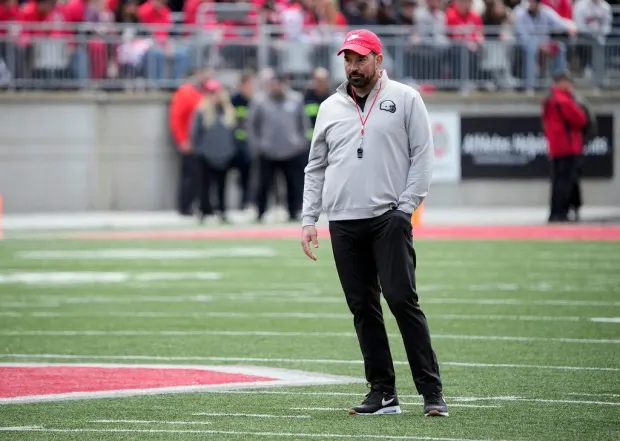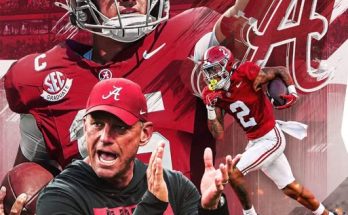Ohio State football rarely misses on top-tier talent. With a coaching staff as aggressive on the trail as it is polished on the field, the Buckeyes have long been a destination for five-star prospects, blue-chip recruits, and NFL-caliber athletes. Yet even a program with that much pedigree isn’t immune to the occasional surprise loss, and it appears a national outlet may have just offered a clue as to why one recent high-profile target slipped away.
The ripple effect started quietly, as most stories like this often do. A top player—one that Ohio State had invested significant time, resources, and recruiting capital into—opted to take his talents elsewhere. Initially, fans and analysts alike chalked it up to a variety of surface-level reasons: geography, family, fit, or simple preference. But a new report has hinted that the story may be deeper—and far more revealing—than it first appeared.
According to a prominent national recruiting outlet, sources close to the player and within the industry have suggested that name, image, and likeness (NIL) considerations played a much larger role in the recruitment than originally believed. While NIL is no longer the elephant in the room when discussing major college football decisions, it’s still a topic few programs like to speak about openly. Yet, this situation may prove to be an inflection point, not just for Ohio State but for the broader landscape of how elite athletes make their decisions in the NIL era.
The recruit in question, whose name is being kept vague by the national outlet for privacy and relationship-maintenance reasons, was reportedly on the verge of committing to Ohio State as recently as a few weeks ago. The Buckeyes were viewed by many insiders as the team to beat. They had already hosted the player multiple times, the coaching staff had developed a strong rapport, and teammates of the prospect had even hinted at a possible Buckeye future. On-field fit? Perfect. Coaching development? No concerns. NFL pipeline? As strong as anywhere in the country. But still, the commitment never came.
The tipping point, per the report, came when the family of the prospect was approached with a significantly more aggressive NIL structure by a rival program. While Ohio State was willing to provide a competitive and structured NIL experience—one focused on long-term earnings potential and brand-building—the other school reportedly pitched a more front-loaded offer. It included guaranteed money, aggressive marketing deals, and the kind of up-front financial security that can be hard for any family to ignore, no matter how prestigious the competing football offer.
This isn’t the first time NIL has been a deciding factor in recruitment battles, but what’s different this time is the revelation of just how close Ohio State was to sealing the deal. According to sources quoted in the article, Ohio State “thought they had him.” The coaching staff had already made post-visit calls to celebrate a potential silent commitment. They were even preparing internal graphics and promotional material for a commitment announcement that never came. Then came the silence. The communication slowed, the excitement cooled, and soon after, the recruit publicly announced his decision for another school—one many considered a long shot until the final days.
Behind the scenes, Ohio State reportedly remains frustrated—but not entirely shocked. This isn’t the first time a top-tier talent has been pried away late in the game thanks to evolving NIL dynamics. One coach, speaking anonymously in the report, expressed concern that “we’re entering a space where it’s not just about development, culture, and playing time—it’s about numbers, and we’re not always going to be the highest bidder.” For a program like Ohio State, which prides itself on balancing elite football tradition with responsible NIL strategy, that’s a tough pill to swallow.
Still, the Buckeyes aren’t backing away from their model. Athletic Director Gene Smith and Head Coach Ryan Day have been vocal about their desire to run a program that integrates NIL without compromising core values. That includes ensuring all NIL deals are above-board, within NCAA guidelines, and built to benefit the player not just immediately but for the long haul. It’s a model that has worked for many current Buckeyes, including household names now thriving in the NFL. But it’s also a model that’s increasingly being tested by more aggressive, upfront NIL tactics elsewhere.
The national outlet’s report has ignited debate across college football forums and recruiting circles. Some argue that Ohio State needs to adjust and become more aggressive in the NIL market. Others believe the Buckeyes are doing things the right way and should not compromise integrity for short-term gain. But what’s clear is that the recruitment landscape is no longer just about football. It’s about business. And in that business, even the biggest names in college football aren’t immune to being outbid.
From the player’s perspective, it’s hard to argue against the decision. This is a life-changing opportunity not just to play football at the highest level but to provide for their family in a way that previous generations of college athletes could only dream of. For many athletes, especially those from underserved communities, the financial offer on the table can feel like the only choice. And while Ohio State has worked hard to be a player in the NIL game, it’s clear there are still programs willing to go even further—sometimes to the point of reshaping an entire recruitment at the eleventh hour.
This development has also added fuel to the ongoing debate about regulation and transparency in NIL. Should there be caps? Should offers be disclosed? Should there be clearer guidelines about what is and isn’t allowed in the recruiting process? Coaches across the country have quietly pushed for more structure, while players and their advocates continue to celebrate the newfound freedom and leverage they’ve earned. It’s a delicate balance that college football is still trying to strike, and situations like this only highlight the stakes involved.
For Ohio State, the miss stings. Not just because they lost an elite talent, but because they thought they’d done everything right. They built the relationship, provided a clear development plan, and even put together a strong NIL pitch. But sometimes, the numbers just don’t add up—and when that happens, even giants like the Buckeyes can find themselves on the outside looking in.
Looking ahead, Ohio State is expected to remain active on the recruiting trail, continuing to target other elite players at the same position. They’ll recalibrate, regroup, and—true to form—come back stronger. But there’s no denying that this particular recruitment will be remembered for more than just the outcome. It’s a symbol of where college football is headed, and a reminder that even the most powerful programs can be vulnerable in a system increasingly driven by financial incentive.
Ultimately, the national outlet’s report doesn’t just answer the question of why the Buckeyes missed on a recruit. It opens a broader conversation about the future of college football recruiting, the role of NIL, and what success looks like in this new era. For fans, it’s a sobering reminder that tradition and prestige aren’t always enough. For Ohio State, it’s a challenge to evolve without losing what made the program great. And for the player, it’s the start of a journey that will now unfold elsewhere—one built on both talent and opportunity.
Time will tell whether the decision works out for all involved. But one thing is certain: the rules of the game have changed. And even the biggest names in college football are learning that sometimes, the most important battles are the ones that never make it to the field.



